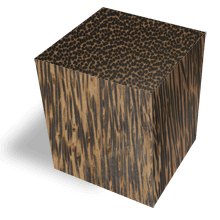
Black Palmira
Black Palmira likely refers to Black Palm (Borassus flabellifer), also known as the Palmyra Palm, a tropical species from the Arecaceae family native to South and Southeast Asia, including India, Sri Lanka, and Indonesia. These palms grow to 50–100 feet tall with a trunk diameter of 1–2 feet, thriving in coastal regions, dry plains, and near water sources. The tree is culturally significant, often harvested for its fruit, sap (used for palm sugar or toddy), and leaves, in addition to its timber.
The heartwood of Black Palmira is distinctively dark, ranging from deep brown to jet-black, often with lighter streaks of brown, tan, or grey running through it, creating a striking contrast. The sapwood is a pale yellowish-white, clearly demarcated from the heartwood. As a palm wood, it doesn’t have true grain like hardwoods; instead, it features a fibrous, vascular structure with bundles of dense fibres embedded in a softer matrix, giving it a speckled, almost dotted appearance in cross-section. The texture is coarse, with a low natural lustre, and the surface can feel rough due to its fibrous nature.
Black Palmira has a density of around 900–1,100 kg/m³, making it extremely hard and heavy, often challenging to work with. The dense fibres can splinter easily, requiring sharp tools and careful handling to avoid tearout or cracking. It’s highly durable, with excellent natural resistance to moisture, insects, and wear, thanks to its dense composition and natural oils. However, its fibrous structure makes gluing difficult, and pre-drilling is recommended for screws or nails. The wood finishes well with oil-based products, which can enhance its dark colour, though its coarse texture may require sanding for a smooth surface.
The wood has a mild, earthy scent when worked, sometimes with a faintly sweet note from the palm’s sap. Black Palmira is often used for small, high-strength applications like knife handles, walking sticks, turned objects (e.g., bowls or pens), and even flooring or furniture inlays where its unique appearance can shine. It’s less common for large-scale projects due to its difficult workability and the small dimensions of palm trunks. The tree’s multi-purpose nature makes its wood harvest relatively sustainable, as it’s often a byproduct of other uses, but the timber remains a niche choice due to its labour-intensive preparation.
